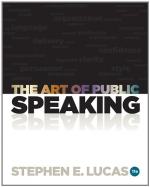Other speakers throw out a still lighter anchor by keeping before them a rather full outline of their written and committed speech.
Others again write and commit a few important parts of the address—the introduction, the conclusion, some vital argument, some pat illustration—and depend on the hour for the language of the rest. This method is well adapted to speaking either with or without notes.
Some speakers read from manuscript the most important parts of their speeches and utter the rest extemporaneously.
Thus, what we have called “joint methods of delivery” are open to much personal variation. You must decide for yourself which is best for you, for the occasion, for your subject, for your audience—for these four factors all have their individual claims.
Whatever form you choose, do not be so weakly indifferent as to prefer the easy way—choose the best way, whatever it cost you in time and effort. And of this be assured: only the practised speaker can hope to gain both conciseness of argument and conviction in manner, polish of language and power in delivery, finish of style and fire in utterance.
QUESTIONS AND EXERCISES
1. Which in your judgment is the most suitable of delivery for you? Why?
2. What objections can you offer to, (a) memorizing the entire speech; (b) reading from manuscript; (c) using notes; (d) speaking from memorized outline or notes; (ee) any of the “joint methods”?
3. What is there to commend in delivering a speech in any of the foregoing methods?
4. Can you suggest any combination of methods that you have found efficacious?
5. What methods, according to your observation, do most successful speakers use?
6. Select some topic from the list on page 123, narrow the theme so as to make it specific (see page 122), and deliver a short address, utilizing the four methods mentioned, in four different deliveries of the speech.
7. Select one of the joint methods and apply it to the delivery of the same address.
8. Which method do you prefer, and why?
9. From the list of subjects in the Appendix select a theme and deliver a five-minute address without notes, but make careful preparation without putting your thoughts on paper.
NOTE: It is earnestly hoped that instructors will not pass this stage of the work without requiring of their students much practise in the delivery of original speeches, in the manner that seems, after some experiment, to be best suited to the student’s gifts. Students who are studying alone should be equally exacting in demand upon themselves. One point is most important: It is easy to learn to read a speech, therefore it is much more urgent that the pupil should have much practise in speaking from notes and speaking without notes. At this stage, pay more attention to manner than to matter—the succeeding chapters take up the composition of the address. Be particularly insistent upon frequent and thorough review of the principles of delivery discussed in the preceding chapters.




